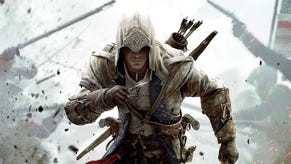Assassin's Creed 3: Ubisoft Montreal's labour of love
Assassin's Creed 3 - one of the most anticipated games of 2012, this week's heavyweight release, and the largest game the series has produced - was developed in a basement.
Ubisoft Montreal is one of the biggest development studios in the world - possibly the very biggest. Assassin's Creed is one of the most important franchises in the industry. It sounds like an ideal marriage; you can imagine the rockstar development team in their comfortable open-plan offices, the cream of the global publisher's talent. You'd be wrong.
"They keep us in the basement, Like, they keep us in the dungeon," mission director Philippe Bergeron told me when I asked what it's like to work on such a lust-worthy property.
"There are no lights. They frost the glass so that we can't see outside. It's really weird being downstairs in that dungeon, because you don't realise that there are four other floors of other people. And then the entire basement is just Assassin's."
To be fair, Ubisoft Montreal has a lot on its plate; it has over 2,500 staff and a finger in almost every one of the publisher's scrumptious pies. Its entire top floor is administrators, and a number of top-notch development groups - Far Cry, Watch Dogs, Splinter Cell, Rainbow Six - are arranged beneath them. To stick the team behind what is arguably Ubisoft's most important property right in the dankest part of the building seems bizarre. We joked that QA, traditionally the least pleasant development role, could be housed in the garage beneath the building; in fact, the testing team is in Romania, allowing for the 24 hour build cycle a game as large as Assassin's Creed 3 requires.
And Assassin's Creed 3 is huge; there's simply no argument there. It's been in development by the core Montreal team since Assassin's Creed 2 wrapped, with other teams stepping in on Brotherhood and Revelations. The amount of content, variety of gameplay and environment is somewhat staggering. You could, presumably, blitz through the main storyline in a couple of days, but why would you, when the game offers you an entire frontier to explore, hunting down resources; building a naval trade empire, chasing down side missions and objectives, and most importantly, stabbing things.
Connor is to Ezio what Ezio was to Altair; a few simple moves have been refined and then iterated on with flourishes and variation. But although Connor is equipped with more tools than his Italian forebears, his move set really shines during the basic combat. For one thing, you can’t just hold down L1 and take a nap, a strategy which has held up through all the previous games.
When it comes to stabbing, Connor is to Ezio what Ezio was to Altair; a few simple moves have been refined and then iterated on with flourishes and variation. But although Connor is equipped with more tools than his Italian forebears, his move set really shines during the basic combat.
For one thing, you can't just hold down L1 and take a nap, a strategy which has held up through all the previous games.
"We completely changed it. We moved to more action-oriented. Before, fights were really safe. You just press down guard and even if you're not looking - you could just look away from the screen - your character's not going to die. He's always going to block," Bergeron agreed.
"This time we wanted to have something that requires a little bit more intricacy to fight properly, so you actually have to time it, to deflect - and that opens up the rest the interactions."
This simple change from a hold to a timed press makes Assasisn's Creed 3's combat much more tense than earlier games, although once you get it right, it's relatively intuitive; this button counters, this button disarms, and so on. It never gets boring, though, because of the sheer variety - and beauty - of execution. I played around with Assassin's Creed 3 for a couple of hours and was constantly surprised by some new way Connor turned an attack, or took out a foe.
"I think this is the biggest animation kit we've had for a character since the beginning. I don't know how many, the exact numbers, but I remember being impressed. It was in the six digits as far as the number of animations," Bergeron said.
"We have different animation teams, so we have like an animation team just for the main character; one for all the NPCs oriented on combat; another one that is for behaviour, like running and climbing; another one for cinematics; another one for crowd life. I don't know. I would say at least a fifth of the staff is animators. I remember on Assassin's Creed 2, just our cinematics team was 40 or 50 people. And it just gets bigger with time. I can't even imagine how big it is now," he added.
Spend a few hours with Assassin's Creed 3 with completion statistics on your mind, and you'll start to get an idea of just how big that Montreal basement is. Perhaps Ubisoft keeps its most precious property down there in the dark for a reason - so there's nothing to distract them from wrapping up a story which has dominated the end of year release season for last four years. No pressure, guys. No pressure at all.
Assassin's Creed 3 arrives on PlayStation 3 and Xbox 360 in the US today, and elsewhere tomorrow. PC and Wii U versions are due in November.











